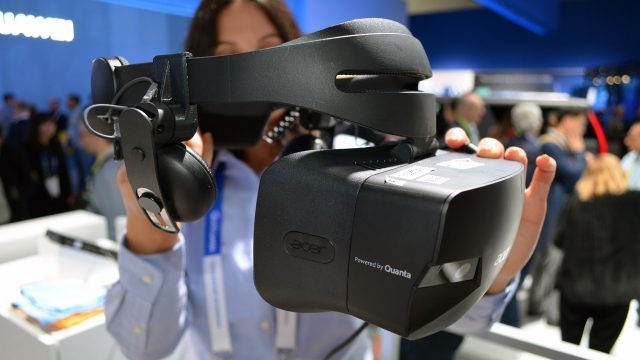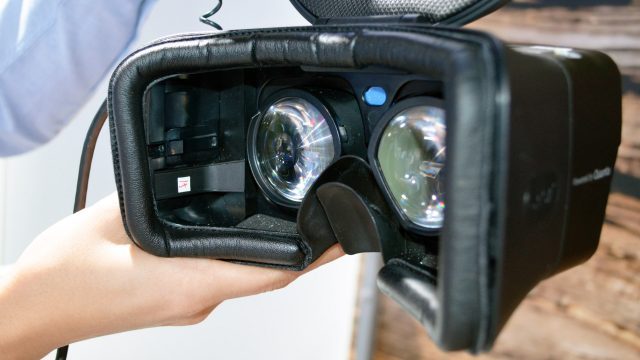This week at CES 2019 Qualcomm is showing off a new VR reference headset sporting impressive new displays that may well define the next wave of VR headsets.
Qualcomm has been a somewhat silent enabler of most of the recent and upcoming standalone VR headsets, not only because it makes the Snapdragon chip that’s central to many of these devices, but also because of its ‘HMD Accelerator’ program which helps companies rapidly bring VR headsets to market by supplying reference designs and pairing companies with partner solutions and capable manufacturers.
Qualcomm’s reference designs act as a jumping-off point for companies to craft a headset to their needs, which could be as simple as slapping a logo on the side, or as extensive as new industrial design, customization of key components, or adding entirely new tech that’s not part of the original reference design. In many cases though, the essential foundation of the reference design can be felt in the end product.
Qualcomm and HTC have worked closely together in the past on Focus, HTC’s first standalone headset, which bore many of the hallmark features found in Qualcomm’s Snapdragon 835 reference headset. Lenovo’s Mirage Solo and a handful of other headsets also share a lineage with one of Qualcomm’s reference designs.
That’s a long way to say this: looking at Qualcomm’s latest reference headsets is a good way to get a preview of devices that are on their way to market.


At CES 2019 this week we met with Qualcomm who was demonstrating what they called a new reference headset that (surprise surprise) had a detachable tether to a smartphone—the feature that HTC massively teased this week with Cosmos, but wasn’t ready to talk about. The USB-C connector on the Qualcomm reference headset could also easily be plugged into a PC, just like HTC says Cosmos will be able to do.
Note: While Qualcomm called the headset a reference design, it appeared to be a newer, unannounced prototype of Acer’s OJO headset, though we gather this is also based on Qualcomm’s latest reference design for smartphone-tetherable headsets designed for Snapdragon 855 devices. For ease of discussion, I’m going to stick to calling this the ‘Qualcomm reference headset’ for now, because the company wasn’t sharing details about how Acer/Quanta were involved.
The similarities don’t stop there. The Qualcomm reference headset also has a flip-up hinge (just like Cosmos), and detachable headphones (just like Cosmos) that looked very similar to those found on the Vive Deluxe Audio strap.
With these similarities, and HTC’s history of working with Qualcomm, the reference headset is almost certainly forms the basis of Vive Cosmos, which gives us a number of big hints about what Cosmos and other near-term headsets could look like.
Which brings us to the display. HTC has said almost nothing about the Cosmos display except that it’s their “sharpest screen yet,” and that the new displays are “real RGB displays” with “minimal screen door effect.”
That’s exactly what I saw in the Qualcomm reference headset, which had a very impressive pair of displays which I don’t believe I’ve ever seen before. These new displays are LCD and running up to 90Hz with a resolution of 2,160 × 2,160 per-eye, a huge step up in pixels (2x!) over leading displays in headsets like the Vive Pro at 1,440 x 1,600 (even before talking about subpixels).
Additionally, these new displays appear to be RGB and have excellent fill-factor, offering the least screen door effect—and sharpest image—I’ve seen in a headset using any display of this type. The field of view on the Qualcomm reference headset looked a little tighter than similar headsets though, likely around 85 degrees, which would have slightly exaggerated the sharpness and minimal screen door. Even so, if these displays can support ~100 degrees like many other headsets, they’d still have a big edge in sharpness and minimal screen door.
It’s not clear if Cosmos will in fact use this 2,160 × 2,160 display. HTC could opt for another display, but if Cosmos will have their “sharpest screen yet,” then it can’t be the Vive Pro display—and if it’s not this new display, then we’re not sure which it would be because there’s no VR displays in any existing or upcoming headsets (to our knowledge) that fall between those two resolutions.
The Qualcomm reference headset also clues us in to what the smartphone tethering function is likely to look like on Cosmos, and the device that would power it.
The Qualcomm reference headset was plugged into a Qualcomm MTP-8150 (an early hardware test kit) based on Snapdragon 855 with 5G hardware built in. The device was powering the headset, rendering the content, and handling the processing necessary for the optical 6DOF tracking. Qualcomm had a local 5G network set up which was streaming volumetric video content from NextVR (which looked really impressive on the high res display) as a 5G proof of concept.
The MTP-8150 is like a reference device for a smartphone, except before all the hardware has been compacted into a sleek form-factor. Phone makers use MTPs to test hardware while designing news phones.
So for Cosmos, the play ahead of HTC very much seems like the company plans to launch a new phone—probably built on Snapdragon 855 and including 5G—that will be compatible with Vive Cosmos. That would explain why HTC wasn’t ready to talk about the headset’s smartphone compatibility—because they’ve yet to announce the phone that will power it.
HTC says they’ll have more to say about Cosmos later this year—pay attention when they gear up to launch their next phone, because that’ll probably be when we start to hear specifics on Cosmos.

